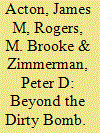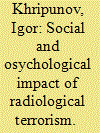|
|
|
Sort Order |
|
|
|
Items / Page
|
|
|
|
|
|
|
| Srl | Item |
| 1 |
ID:
079568


|
|
|
| 2 |
ID:
049737


|
|
|
|
|
| Summary/Abstract |
Despite legal precedent and his U.S. citizenship, Jose Padilla was held as an enemy combatant for the past 18 months. Is this "known terrorist" really a dangerous Al Qaeda operative, or is his case just another reason to question the constitutionality of the administration's war on terror?
|
|
|
|
|
|
|
|
|
|
|
|
|
|
|
|
| 3 |
ID:
075778


|
|
|
|
|
| Publication |
2006.
|
| Summary/Abstract |
Nuclear terrorism in all its forms is the common enemy of all mankind. Given the emergence of global, non-state terrorism, China must be prepared to confront such threats. A terrorist attack using a functional nuclear device would be devastating. A radiological dispersion device or "dirty bomb" is another form-much less deadly and easier to build than even a crude nuclear device. China believes that to combat nuclear terrorism, it is vital to enhance the security of nuclear materials. Beijing has taken substantial steps in this direction, as well as in increasing the protection of its nuclear facilities, but much work remains to be done, including improving its management and control of radioactive sources and clarifying the design basis threat for critical installations. Ultimately, however, the most effective security will come from strengthening the international nonproliferation and nuclear control regimes.
|
|
|
|
|
|
|
|
|
|
|
|
|
|
|
|
| 4 |
ID:
075779


|
|
|
|
|
| Publication |
2006.
|
| Summary/Abstract |
The July 2005 terrorist attacks in London demonstrated the resilience of Western society in the face of low-level conventional terrorism. But the psychological damage from the London bombings would likely pale next to the severe, unpredictable, long-lasting effects of a radiological attack. One unique hazard of radiation exposure beyond the obvious physiological effects is that it is colorless, odorless, and tasteless, making it difficult for ordinary citizens to evaluate, quantify, and rationally understand the dangers confronting them. Radiological weapons stand out among the tools available to terrorists for their capacity to inflict far-reaching psychological damage to civilian populaces well beyond the immediate victims. A possible solution to mitigate the psychological consequences is to build a "resilience culture," an interlocking set of beliefs, attitudes, approaches, and behaviors that help people fare better in any disaster or extraordinary circumstance. The "all-hazards approach," which emphasizes the identifiable similarities among the "disaster triad"-that is, natural, accidentally man-made, and intentionally man-made disasters-extends to acts of terrorism and could help demystify the fears associated with radiological terrorist weapons.
|
|
|
|
|
|
|
|
|
|
|
|
|
|
|
|
|
|
|
|
|